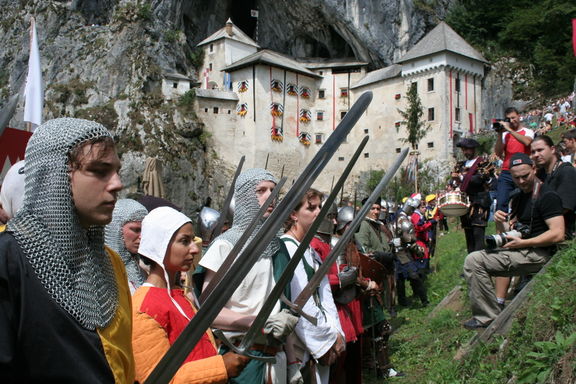Difference between revisions of "Predjama Castle"
Ivan Pirnat (talk | contribs) m |
Ivan Pirnat (talk | contribs) m |
||
| Line 21: | Line 21: | ||
{{Teaser| | {{Teaser| | ||
| − | Situated just a few kilometres from the entrance to [[Postojna Cave]] stands | + | [[Predjama Castle]] one of the most picturesque castles in Slovenia, is built into overhanging rock of hill in front of Karst cave under stone beneath |
| + | Situated just a few kilometres from the entrance to [[Postojna Cave]] stands [[Predjama Castle]] and probably wider. | ||
| + | The castle was first mentioned in the year [[established ::1274]] with the German name Luegg, when the Patriarch of Aquileia built the castle in Gothic style. The castle was built under a natural rocky arch high in the stone wall to make access to it difficult. It was later acquired and expanded by the Luegg noble family, also known as the Knights of Adelsberg (the German name of Postojna). | ||
| + | Construction began in the 13th century, but it is first mentioned in the mid 14th century as ''Castrum Lafcram a Carsis Positum'', which means 'Cave Castle in the Karst'. It belonged under jurisdiction of the patriarchs of Aquileia and was inhabited by several knights that protected their interests in the region. When the power of the Aquileian patriarchs declined, the castle was seized by the Habsburgs, who also invested various vassals with it. The first Slovene associated with the castle was A Konrad, burgravio di Jama, who is mentioned in 1397. In 1478 Emperor Frederick III invested Erasmus Lueger, whom Slovene historians call Erasmus of Predjama, with the castle. Then in 1567 Austrian Archduke Karel invested Ivan Kobencl from Prosek with the 'Jama' manor. At that time the castle was in a very poor condition, so the new lord renovated it in Renaissance style. The last Kobencl bequeathed Predjama Castle to his relative, Count Mihael Coronini from Kromberk, whose wife sold the fortress to Prince Weriand Windischgrätz in 1846. Thereafter it remained in hands of the Windischgrätz family until 1945, when it was nationalised. | ||
}} | }} | ||
| Line 34: | Line 37: | ||
==External Links== | ==External Links== | ||
| + | * [http://en.wikipedia.org/wiki/Predjama_Castle Predjama Castle on Wikipedia] | ||
* [http://www.predjamski-grad.si/en-index Predjama Castle website] | * [http://www.predjamski-grad.si/en-index Predjama Castle website] | ||
* [http://kraji.eu/search_pic/predjama%20castle/eng Predjama Castle on Kraji.eu website] | * [http://kraji.eu/search_pic/predjama%20castle/eng Predjama Castle on Kraji.eu website] | ||
Revision as of 23:41, 23 January 2010
First Predjama Castle has been managed by the Notranjska Museum in Postojna. Since the late 1990s the castle has been under renovation with the aim of restoring it to how it would have looked in the time of Ivan Kobenci, a period when castles were steadily losing their defensive function. Since 2007 the Castle is managed by the Turizem KRAS company located in Postojna, while some objects situated at the Castle are owned by the Notranjska Museum, Postojna.
A centuries-old linden stands in front of the castle and legend has it that Erasmus of Predjama is buried underneath it. The small Gothic church in front of the castle was recently renovated; its main attractions are frescoes from the 15th century and a Baroque altar.
See also



